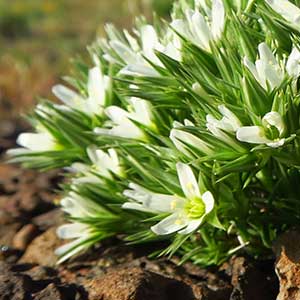Eremogone franklinii
Eremogone aculeata
Franklin's sandwort
needle-leaf sandwort, prickly sandwort
erect, 3–10(–15) cm, glabrous.
erect, 7–25(–30) cm, densely stipitate-glandular distally.
basal leaves persistent;
cauline leaves in 6–10 pairs, closely overlapping, not reduced;
basal blades arcuate-spreading, needlelike, (0.6–)1–2 cm × ca. 1 mm, ± rigid, herbaceous, apex spinose, glabrous, not glaucous.
basal leaves persistent;
cauline leaves in 1–3 pairs, abruptly reduced distal to lowest pair;
basal blades ascending or often arcuate-spreading, needlelike, (0.5–)1–2.5(–3.5) cm × 0.5–1.5 mm, rigid, herbaceous, apex spinose, glabrous to puberulent, glaucous.
3–45+-flowered, usually congested, subcapitate cymes.
5–25+-flowered, open cymes.
ca. 0.1–3(–4) mm, glabrous.
3–25 mm, stipitate-glandular.
sepals 1–3-veined, linear-lanceolate, (5–)8.5–12 mm, not enlarging in fruit, margins narrow, apex acuminate, glabrous;
petals white, oblong-lanceolate to narrowly spatulate, 7–9 mm, 0.8–1.1 times as long as sepals, apex rounded to blunt;
nectaries not apparent.
sepals 1–3-veined, lateral veins less developed or all obscure, ovate, 3–4.5 mm, to 6 mm in fruit, margins broad, apex usually obtuse to rounded, abruptly acute, sparsely to densely stipitate-glandular;
petals white, obovate to oblanceolate, 4.5–10 mm, 1.5–3 times as long as sepals, apex rounded;
nectaries as lateral and abaxial rounding, with slight lateral expansion, at base of filaments opposite sepals, 0.3 mm.
2.3–3.3 mm, glabrous.
5–9 mm, glabrous.
black, pyriform, 1.2–1.7 mm, tuberculate.
yellowish tan to gray, ellipsoid-oblong, 1.8–2.5(–3.2) mm, tuberculate;
tubercles rounded, elongate.
= 22.
Eremogone franklinii
Eremogone aculeata
Varieties 2 (2 in the flora).
(Discussion copyrighted by Flora of North America; reprinted with permission.)
Some specimens from north-central California and southwestern Oregon have been named Arenaria pumicola var. californica. R. L. Hartman (1993) considered those plants to be robust forms of Eremogone aculeata, not deserving formal recognition. Based on work by M. F. Baad (1969), they warrant further study.
Reports of Eremogone aculeata from Arizona, New Mexico, and Wyoming are erroneous.
(Discussion copyrighted by Flora of North America; reprinted with permission.)
1. Inflorescences tightly congested cymes; pedicels 0.1-1(-3) mm; sepals 8.5-12 mm; petals 0.8-0.9 times as long as sepals | var. franklinii |
1. Inflorescences somewhat congested cymes; pedicels 1-4 mm; sepals 5-8 mm; petals 1-1.1 times as long as sepals | var. thompsonii |
- Local floras:
OR,
WA
- Local Web sites:
CalFlora,
CalPhotos,
Flora NW,
PNW Herbaria
WildflowerSearch
iNaturalist (observations)
- LBJ Wildflower Center
- SEINet
- Plants of the World Online
- Encyclopedia of Life
- Wikipedia
- Google Image Search
- Local floras:
CA,
OR,
WA
- Local Web sites:
CalFlora,
CalPhotos,
Flora NW,
PNW Herbaria
WildflowerSearch
iNaturalist (observations)
USDA Plants Database
- LBJ Wildflower Center
- SEINet
- Plants of the World Online
- Encyclopedia of Life
- Wikipedia
- Google Image Search
